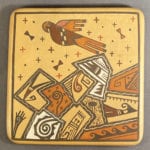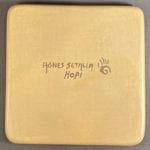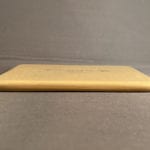This tile is much busier and dynamic than most Hopi tiles, yet it retains a sense of serenity and grace. Above a field of pottery shards, a Sikyatki parrot flies in a sky full of crosses, dots and butterflies.
The soft “thunk” heard when striking the tile with a finger indicates an outdoor firing, but there is no evidence of blushing. The edges and corners have been rounded smooth.
A single black line borders the design. Eleven black-bordered shards fill the lower two-thirds of the tile, each with a different design. Wavy etched lines meander within these borders, adding a subtle sense of motion. The shards display a variety of backgrounds: 5 are unpainted, 3 red, 2 are white, and 1 is stippled. The designs are both linear and curvilinear but all are carefully drawn. One displays a human hand, the rest are geometric.
A Sikyatki parrot launches itself off the shards into the space above. The bird is polychromatic with an orange beak and a dark maroon body inset with a band of alternating black and white rectangles. The leading edge of stylized wing above is light red with an orange rear branching into 3 feathers with squared black tips. The core of the body is separated from the rear by a thick black “V” shape, its tip forward-pointing. The tail of the body has the same orange color and form seen on the top wing: three feathers with black tips.
The sky around the bird is filled with a constellation of 17 crosses, 9 black dots and 3 butterflies. The crosses are painted with both black and red paint. Of the 9 crosses to the left of the bird, 6 are black and 3 are red. Of the 8 crosses to the right of the bird, 6 are black and 2 are red. The 2 butterflies to the left of the bird are painted black; the single butterfly to the right is red.
I do not know if Agnes intended the tile to convey a particular meaning, but the shards below might represent different clan corn fields, the bird above being a messenger carrying prayers for rain. Butterflies emerge at Hopi after spring rains. What we see as crosses might represent dragonflies, who propagate and gather near summer water. Both elements indicate “siitalpuva,” a glittering world of bounty and peace (Hays-Gilpin and Sekaquaptewa, 2006, 12-25). The black dots might be the stars that shine so brightly in the clear, dark night sky at Hopi. Such interpretation is consistent with Hopi iconography, but might only be a product of my imagination.
In any case the composition and painting on tile 2019-23 is a testament to the skill of Agnes Setalla Nahsonhoya. Her mother Pauline Setalla was an accomplished potter, as are her brothers Stetson Setalla and Dee Setalla and her sister Gwen Setalla. All are represented in this collection and their pots can be located through the Artist List.




